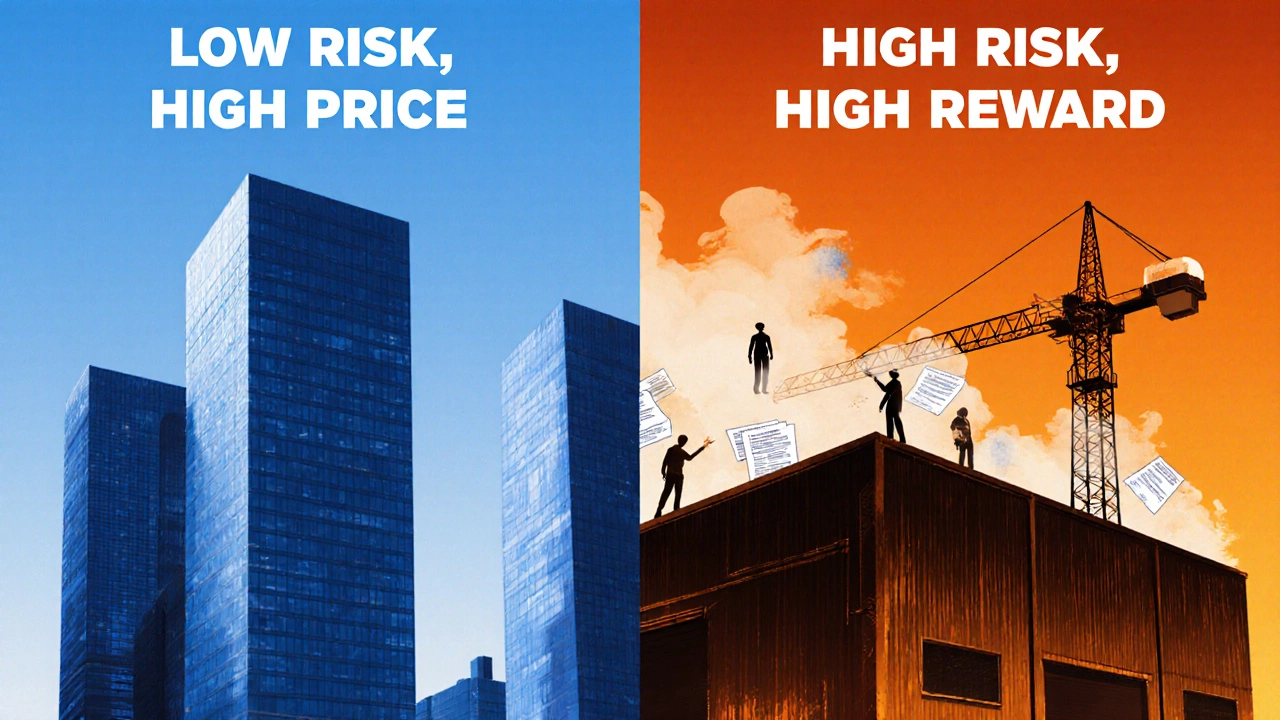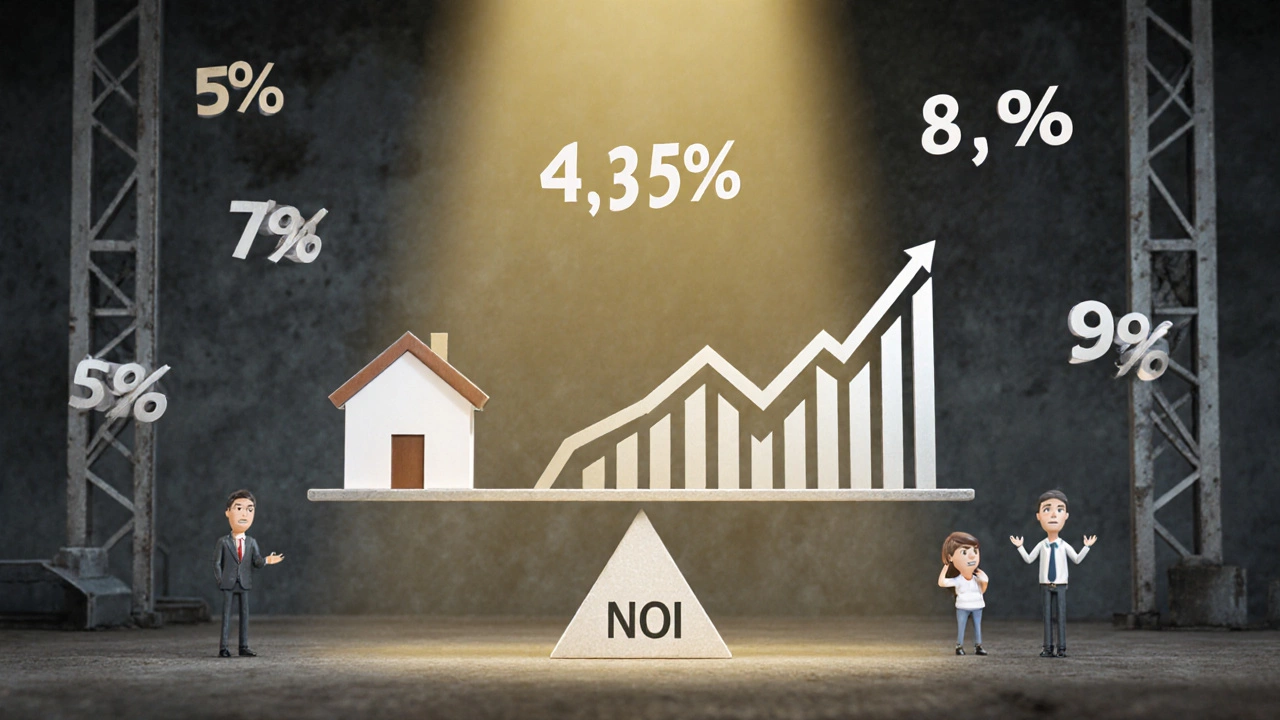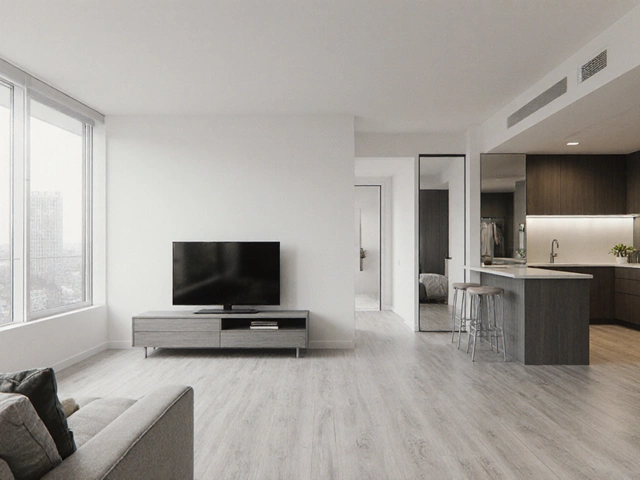Cap Rate Calculator for Commercial Real Estate
Calculate Your Commercial Property Cap Rate
Cap rate (capitalization rate) helps you determine the expected return on a commercial property based on its net income and market value. Enter any two values to calculate the third.
Key Insights from the Article
Remember: Lower cap rates = higher price = less risk. A 5.5% cap rate might be safer than a 9% cap rate, but depends on your investment goals and risk tolerance.
Don't confuse cap rate with cash-on-cash return. Cap rate assumes cash purchase while cash-on-cash includes financing.
When you’re looking at a commercial property-like an office building, shopping center, or warehouse-you don’t just care about the price tag. You care about how much money it can make you. That’s where the cap rate comes in. It’s the single most important number you’ll see in a commercial real estate listing, and if you don’t understand it, you could overpay-or miss out on a great deal.
What Exactly Is the Cap Rate?
The cap rate, short for capitalization rate, is a simple formula that tells you the expected return on a commercial property based on its net income and current market value. You don’t need a finance degree to use it. The math is straightforward:
Cap Rate = Net Operating Income (NOI) ÷ Property Value
Let’s say you’re looking at a small retail building in Melbourne’s outer suburbs. The seller says it’s listed for $1.8 million. Last year, after paying all operating expenses-property taxes, insurance, maintenance, management fees, and utilities-but before mortgage payments, the building brought in $126,000 in rent. That’s the Net Operating Income (NOI).
So: $126,000 ÷ $1,800,000 = 0.07, or 7%.
That means the property has a 7% cap rate. In plain terms: if you bought it with cash, you’d earn a 7% return every year before any financing or taxes.
Why Cap Rate Matters More Than Rent Alone
Many first-time investors get fooled by high rental income. A property might bring in $150,000 a year in rent-but if it costs $3 million, that’s only a 5% return. Another property might only make $90,000 in rent but cost $1 million-that’s a 9% return. The higher rent doesn’t mean it’s a better deal. The cap rate does.
Think of it like comparing two cars. One costs $40,000 and gets 12 km per liter. Another costs $25,000 and gets 18 km per liter. Which is more efficient? You don’t just look at how far it goes-you look at the cost per kilometer. Cap rate is the cost-per-dollar-of-income.
In commercial real estate, cap rates help you compare apples to apples. A 50-unit apartment complex in Sydney and a single-tenant medical office in Adelaide can both be evaluated using the same metric. That’s why professionals rely on it.
What’s a Good Cap Rate?
There’s no universal number that’s "good" or "bad." It depends on the market, the property type, and risk.
In Melbourne’s CBD right now, prime office buildings might trade at 4.5% to 5.5% cap rates. Why so low? Because they’re stable, in high demand, and considered low-risk. Investors are willing to pay more for safety.
But a warehouse in regional Victoria? That might be trading at 7% to 8%. Why? It’s riskier-fewer tenants, longer vacancies, less demand. So the return has to be higher to attract buyers.
Here’s a rough guide for 2025 in Australia:
- Prime CBD offices: 4.0% - 5.5%
- Regional retail centers: 6.0% - 7.5%
- Medical clinics: 5.5% - 7.0%
- Industrial warehouses: 6.5% - 8.5%
- Hotels or serviced apartments: 7.0% - 9.0%
Remember: lower cap rate = higher price = less risk. Higher cap rate = lower price = more risk.

How Cap Rate Relates to Interest Rates
Cap rates don’t move in a vacuum. They’re closely tied to interest rates. When the Reserve Bank of Australia hikes rates, borrowing gets more expensive. That pushes cap rates higher.
Why? Because investors need a bigger return to make up for the cost of loans. If your mortgage rate goes from 5% to 7%, you need a property with a cap rate higher than 7% just to break even. So sellers have to lower prices (or cap rates rise) to attract buyers.
That’s why cap rates tend to rise during tight credit markets and fall when money is cheap. In 2023, when rates were low, cap rates in Sydney dropped to historic lows. By 2025, with rates holding steady at 4.35%, cap rates have stabilized-but still sit above 2021 levels.
What Cap Rate Doesn’t Tell You
Cap rate is powerful-but it’s not the whole story. It ignores financing. It doesn’t account for future rent increases, property appreciation, or tax benefits.
For example, a property with a 7% cap rate might seem better than one at 5%. But if the 5% property has a 10-year lease with a tenant like Coles or Bunnings, and the 7% property has a tenant who might leave next year, the lower cap rate might be the smarter buy.
Also, cap rate doesn’t include capital improvements. If you buy a 1980s warehouse that needs $300,000 in upgrades, your actual return won’t be 7%-it’ll be lower until you spend that money.
And cap rate doesn’t reflect location trends. A property in a growing suburb might have a 7% cap rate today but could jump to 9% in value in three years. That’s appreciation-and cap rate doesn’t capture that.
How to Use Cap Rate in Real Negotiations
When you’re reviewing a listing, always ask for the NOI. Sellers often list "gross rent"-but that’s misleading. You need the net number.
Here’s what to do:
- Ask for the last 12 months of financials: rent rolls, expense statements, property tax bills.
- Verify the NOI yourself. Are management fees realistic? Is insurance inflated? Are vacancies factored in?
- Calculate the cap rate. If it’s way higher than similar properties, ask why.
- Compare it to recent sales in the area. If comparable buildings sold at 6.8%, but this one’s at 8.5%, there’s probably a reason-bad tenant, structural issues, zoning risks.
Don’t trust the seller’s cap rate. Do your own math. A 2% difference in cap rate can mean hundreds of thousands in value.

Cap Rate vs. Cash-on-Cash Return
Don’t confuse cap rate with cash-on-cash return. They’re both returns-but they measure different things.
Cap rate assumes you paid cash. It’s a pure property performance metric.
Cash-on-cash return is what you actually pocket after putting down a deposit and paying a mortgage. Let’s say you buy a $1.8 million property with a 20% down payment ($360,000). Your annual mortgage payment is $78,000. Your NOI is still $126,000. So your cash flow is $126,000 - $78,000 = $48,000.
Your cash-on-cash return: $48,000 ÷ $360,000 = 13.3%.
That’s higher than the cap rate-but it’s not the property’s true performance. It’s your return based on how much you put in. Cap rate tells you about the asset. Cash-on-cash tells you about your deal.
Common Cap Rate Mistakes Investors Make
Here are the top three mistakes I’ve seen:
- Using gross rent instead of NOI. A $150,000 rent doesn’t mean $150,000 income. Subtract $40,000 in expenses and you’re at $110,000. That changes your cap rate dramatically.
- Ignoring vacancy rates. If the property is 90% occupied but the seller assumes 100%, you’re overpaying. Always use realistic occupancy.
- Comparing across property types. A 6% cap rate on a medical clinic isn’t the same as 6% on a strip mall. Different tenants, different risks. Always compare similar assets.
How Cap Rate Helps You Decide What to Buy
If you’re a conservative investor looking for steady income, aim for properties with 5%-6.5% cap rates in stable areas. Think government leases, national retailers, or long-term medical tenants.
If you’re willing to take on more risk for higher returns, look at 7%-9% cap rates in up-and-coming suburbs. Maybe a warehouse near a new logistics hub. You might need to re-tenant it, but the upside could be huge.
And if you see a property with a 10%+ cap rate? Be very careful. That’s often a red flag-structural problems, legal issues, or a tenant about to walk. Dig deeper before you make an offer.
Cap rate isn’t magic. But it’s the first filter every serious investor uses. It separates the hype from the numbers. And in commercial real estate, numbers don’t lie.
Is a higher cap rate always better in commercial real estate?
Not always. A higher cap rate means the property is priced lower relative to its income, which usually means higher risk-like older buildings, weaker tenants, or unstable markets. A 9% cap rate might look tempting, but if the tenant leaves next year, you could be stuck with a vacant building and no income. A 5.5% cap rate on a property with a 10-year lease from a major retailer is often a safer, more reliable investment.
Can cap rate be negative?
Yes, but it’s a warning sign. If your property’s operating expenses are higher than the rent it brings in, your NOI is negative. That means your cap rate is negative. This happens when a building is poorly managed, over-leveraged, or in decline. A negative cap rate means you’re losing money just to own it-unless you plan to redevelop or reposition it, avoid it.
How often should I recalculate the cap rate on my property?
Recalculate it every year, or whenever there’s a major change: new lease, rent increase, big repair, or tenant turnover. Cap rate isn’t static. If your property’s rent goes up 5% and expenses stay flat, your cap rate improves. If you have a vacancy for six months, your cap rate drops. Tracking it helps you spot problems early or know when to sell.
Does cap rate include property taxes?
Yes. Property taxes are part of operating expenses, and operating expenses are subtracted from gross rent to get Net Operating Income (NOI). So cap rate includes property taxes, insurance, maintenance, management fees, and utilities-but not mortgage payments, income taxes, or capital improvements.
How do I find cap rates for properties in my area?
Commercial real estate brokers and property data platforms like CoreLogic or RPD publish recent sale data with cap rates. You can also ask your commercial real estate agent for comps-recent sales of similar properties. Don’t rely on listing websites; they often use inflated rent numbers. Real cap rates come from actual transactions, not asking prices.






